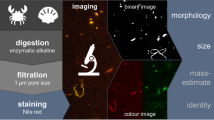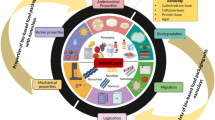Abstract
A polystyrene ELISA plate (EP) modified with a thin film based on gold nanoseeds (AuSDs) assembled onto polydopamine (PDA) is proposed. The nanodecorated film (PDA@AuSD) allows to evaluate the polyphenols antioxidant capacity (AOC) through a colorimetric approach based on a seed-mediated growth strategy. Polyphenols, in the presence of the nanodecorated (PDA@AuSD) surfaces are able to drive an increase in size of the AuSDs according to their AOC; this produces an increase of the localized surface plasmon resonance (LSPR; maximum at λ ~ 550 nm) that is taken as analytical signal. The PDA@AuSD EP manufacturing shows good intraplates repeatability (RSD ≤ 6.6%, n = 96 wells) and interplates reproducibility (RSD ≤ 7.4%, n = 748 wells), resulting stable for 1 year. The AuSDs growth kinetic has been studied using 11 polyphenols belonging to different chemical classes and 4 different food samples. The PDA@AuSD film is able to return quantitative information on the AOC of food polyphenols. Good repeatability (RSD ≤ 5.7%, n = 12 EP wells) and reproducibility (RSD ≤ 8.1%, n = 12 EP wells) was achieved, with acceptable linear correlation coefficients (R2 ≥ 0.990) and useful limits of detection (LODs ≤ 2.5 10−5 mol L−1). The samples analyzed with the PDA@AuSD device have been successfully ordered according to their AOC in agreement with conventional optical methods. The PDA@AuSD plate allows multiple measurements (96 wells per EP) with a one-step strategy, overcoming the limitations related to the use of colloidal nanoparticles; in addition, since absorbance is measured after washing, it is not affected by sample color or turbidity.

Schematic representation of ELISA plate (EP) modified with polydopamine (PDA) film decorated with gold nanoseeds (AuSD). The colorimetric assay, to evaluate the antioxidant capacity, is based on the AuSD growth mediated by polyphenols, resulting in absorbance increase at 550 nm (ΔAbs550), which is employed as analytical signal.




Similar content being viewed by others
References
Huang CC, Chen W (2018) A SERS method with attomolar sensitivity: a case study with the flavonoid catechin. Microchim Acta 180:120–128. https://doi.org/10.1007/s00604-017-2662-9
Dela Pelle F, Compagnone D (2018) Nanomaterial-based sensing and biosensing of phenolic compounds and related antioxidant capacity in food. Sensors 18:462. https://doi.org/10.3390/s18020462
Tonello NV, D’Eramo F, Marioli JM, Crevillen AG, Escarpa A (2018) Extraction-free colorimetric determination of thymol and carvacrol isomers in essential oils by pH-dependent formation of gold nanoparticles. Microchim Acta 185:2–9. https://doi.org/10.1007/s00604-018-2893-4
Vilela D, González MC, Escarpa A (2012) Sensing colorimetric approaches based on gold and silver nanoparticles aggregation: chemical creativity behind the assay. A review. Anal Chim Acta 751:24–43. https://doi.org/10.1016/j.aca.2012.08.043
Della Pelle F, Scroccarello A, Scarano S, Compagnone D (2018) Silver nanoparticles-based plasmonic assay for the determination of sugar content in food matrices. Anal Chim Acta 1051:129–137Della Pelle F, Scroccarello A, Scarano S, Compagnone D (2018) Silver nanoparticles-based plasmonic assay for the determination of sugar content in food matrices. Anal Chim Acta 1051:129–137
Vilela D, Castañeda R, González MC, Mendoza S, Escarpa A (2015) Fast and reliable determination of antioxidant capacity based on the formation of gold nanoparticles. Microchim Acta 182:105–111. https://doi.org/10.1007/s00604-014-1306-6
Della Pelle F, González MC, Sergi M et al (2015) Gold nanoparticles-based extraction-free colorimetric assay in organic media: an optical index for determination of total polyphenols in fat-rich samples. Anal Chem 87:6905–6911. https://doi.org/10.1021/acs.analchem.5b01489
Della Pelle F, Scroccarello A, Sergi M, Mascini M, del Carlo M, Compagnone D (2018) Simple and rapid silver nanoparticles based antioxidant capacity assays: reactivity study for phenolic compounds. Food Chem 256:342–349. https://doi.org/10.1016/j.foodchem.2018.02.141
Della Pelle F, Vilela D, González MC, Lo Sterzo C, Compagnone D, del Carlo M, Escarpa A (2015) Antioxidant capacity index based on gold nanoparticles formation. Application to extra virgin olive oil samples. Food Chem 178:70–75. https://doi.org/10.1016/j.foodchem.2015.01.045
Kailasa SK, Koduru JR, Desai ML et al (2018) Recent progress on surface chemistry of plasmonic metal nanoparticles for colorimetric assay of drugs in pharmaceutical and biological samples. TrAC Trends Anal Chem 105:106–120. https://doi.org/10.1016/j.trac.2018.05.004
Kasibabu BSB, Bhamore JR, D’souza SL, Kailasa SK (2015) Dicoumarol assisted synthesis of water dispersible gold nanoparticles for colorimetric sensing of cysteine and lysozyme in biofluids. RSC Adv 5:39182–39191. https://doi.org/10.1039/c5ra06814b
Rawat KA, Kailasa SK (2014) Visual detection of arginine, histidine and lysine using quercetin-functionalized gold nanoparticles. Microchim Acta 181:1917–1929. https://doi.org/10.1007/s00604-014-1294-6
Özyürek M, Güngör N, Baki S et al (2012) Development of a silver nanoparticle-based method for the antioxidant capacity measurement of polyphenols. Anal Chem 84:8052–8059. https://doi.org/10.1021/ac301925b
Teerasong S, Jinnarak A, Chaneam S, Wilairat P, Nacapricha D (2017) Poly (vinyl alcohol) capped silver nanoparticles for antioxidant assay based on seed-mediated nanoparticle growth. Talanta 170:193–198. https://doi.org/10.1016/j.talanta.2017.04.009
Rostami S, Mehdinia A, Jabbari A (2017) Seed-mediated grown silver nanoparticles as a colorimetric sensor for detection of ascorbic acid. Spectrochim Acta - Part A Mol Biomol Spectrosc 180:204–210. https://doi.org/10.1016/j.saa.2017.03.020
Palladino P, Bettazzi F, Scarano S (2019) Polydopamine: surface coating, molecular imprinting, and electrochemistry—successful applications and future perspectives in (bio)analysis. Anal Bioanal Chem 411:4327–4338. https://doi.org/10.1007/s00216-019-01665-w
Bernsmann F, Ball V, Ponche A, et al (2011) Dopamine - melanin film deposition depends on the used oxidant and buffer solution. 2819–2825
Ball V, Del Frari D, Toniazzo V, Ruch D (2012) Kinetics of polydopamine film deposition as a function of pH and dopamine concentration: insights in the polydopamine deposition mechanism. J Colloid Interface Sci 386:366–372. https://doi.org/10.1016/j.jcis.2012.07.030
Ryu JH, Messersmith PB, Lee H (2018) Polydopamine surface chemistry: a decade of discovery. ACS Appl Mater Interfaces 10:7523–7540. https://doi.org/10.1021/acsami.7b19865
Ding YH, Floren M, Tan W (2016) Mussel-inspired polydopamine for bio-surface functionalization. Biosurface and Biotribology 2:121–136. https://doi.org/10.1016/j.bsbt.2016.11.001
Teo PS, Rameshkumar P, Pandikumar A, Jiang ZT, Altarawneh M, Huang NM (2017) Colorimetric and visual dopamine assay based on the use of gold nanorods. Microchim Acta 184:4125–4132. https://doi.org/10.1007/s00604-017-2435-5
Ma Y, Niu H, Cai Y (2011) One-step synthesis of silver/dopamine nanoparticles and visual detection of melamine in raw milk:4192–4196. https://doi.org/10.1039/c1an15327g
Della Pelle F, Daniel R, Scroccarello A et al (2019) High-performance carbon black/molybdenum disulfide nanohybrid sensor for cocoa catechins determination using an extraction-free approach. Sensors Actuators B Chem 296:126651. https://doi.org/10.1016/j.snb.2019.126651
Della Pelle F, Blandón-Naranjo L, Alzate M, et al (2020) Cocoa powder and catechins as natural mediators to modify carbon-black based screen-printed electrodes. Application to free and total glutathione detection in blood. Talanta 207: 120349. https://doi.org/10.1016/j.talanta.2019.120349
Zhou Y, Lin W, Yang F et al (2014) Insights into formation kinetics of gold nanoparticles using the classical JMAK model. Chem Phys 441:23–29. https://doi.org/10.1016/j.chemphys.2014.07.001
Njoki PN, Luo J, Kamundi MM, Lim S, Zhong CJ (2010) Aggregative growth in the size-controlled growth of monodispersed gold nanoparticles. Langmuir 26:13622–13629. https://doi.org/10.1021/la1019058
Schneider CA, Rasband WS, Eliceiri KW (2012) NIH image to ImageJ: 25 years of image analysis. Nat Methods 9:671–675
Jelinek HF, Miloševi NT, Karperien A, Krstonoši B (2013) Box-counting and multifractal analysis in neuronal and glial classification. Adv Intell Control Syst Comput Sci AISC 187:177–189
Filho Barros MN, Sobreira FJA (2014) Accuracy of lacunarity algorithms in texture classification of accuracy of lacunarity algorithms in texture classification of high spatial resolution images from urban areas. Int Arch Photogramm Remote Sens Spat Inf Sci XXXVII:
Karperien A (2014) FracLac for ImageJ. https://doi.org/10.13140/2.1.4775.8402
Re R, Pellegrini N, Proteggente A, Pannala A, Yang M, Rice-Evans C (1999) Antioxidant activity applying an improved ABTS radical cation decolorization assay. Free Radic Biol Med 26:1231–1237. https://doi.org/10.1016/S0891-5849(98)00315-3
Scarano S, Pascale E, Palladino P et al (2018) Determination of fermentable sugars in beer wort by gold nanoparticles@polydopamine: a layer-by-layer approach for localized surface plasmon resonance measurements at fixed wavelength. Talanta 183:24–32. https://doi.org/10.1016/j.talanta.2018.02.044
Jha PK, Halada GP (2011) The catalytic role of uranyl in formation of polycatechol complexes. Chem Cent J 5:1–7. https://doi.org/10.1186/1752-153X-5-12
Della Pelle F, Di Battista R, Vázquez L et al (2017) Press-transferred carbon black nanoparticles for class-selective antioxidant electrochemical detection. Appl Mater Today 9:29–36. https://doi.org/10.1016/j.apmt.2017.04.012
Rojas D, Della Pelle F, Carlo D, Michele Fratini E, Escarpa A, Compagnone D (2019) Nanohybrid carbon black-molybdenum disulfide transducers for preconcentration-free voltammetric detection of the olive oil o-diphenols hydroxytyrosol and oleuropein. Microchim Acta 186:363. https://doi.org/10.1007/s00604-019-3418-5
Shrivastava A, Gupta V (2011) Methods for the determination of limit of detection and limit of quantitation of the analytical methods. Chronicles Young Sci 2:21. https://doi.org/10.4103/2229-5186.79345
Scroccarello A, Della Pelle F, Neri LN, Pittia P, Compagnone D (2019) Silver and gold nanoparticles based colorimetric assays for the determination of sugars and polyphenols in apples. Food Res Int 119:359–368. https://doi.org/10.1016/j.foodres.2019.02.006
Funding
FDP thanks the Ministry of Education, University and Research (MIUR), and the European Social Fund (ESF) for the PON R&I 2014-2020 program, action 1.2 “AIM: Attraction and International Mobility” (AIM1894039-3). EF and GF kindly acknowledge partial financial support from CSGI.
Author information
Authors and Affiliations
Corresponding authors
Ethics declarations
Conflict of interest
The author(s) declare that they have no competing interests.
Additional information
Publisher’s note
Springer Nature remains neutral with regard to jurisdictional claims in published maps and institutional affiliations.
Electronic supplementary material
ESM 1
(PDF 776 kb)
Rights and permissions
About this article
Cite this article
Scroccarello, A., Della Pelle, F., Fratini, E. et al. Colorimetric determination of polyphenols via a gold nanoseeds–decorated polydopamine film. Microchim Acta 187, 267 (2020). https://doi.org/10.1007/s00604-020-04228-4
Received:
Accepted:
Published:
DOI: https://doi.org/10.1007/s00604-020-04228-4




